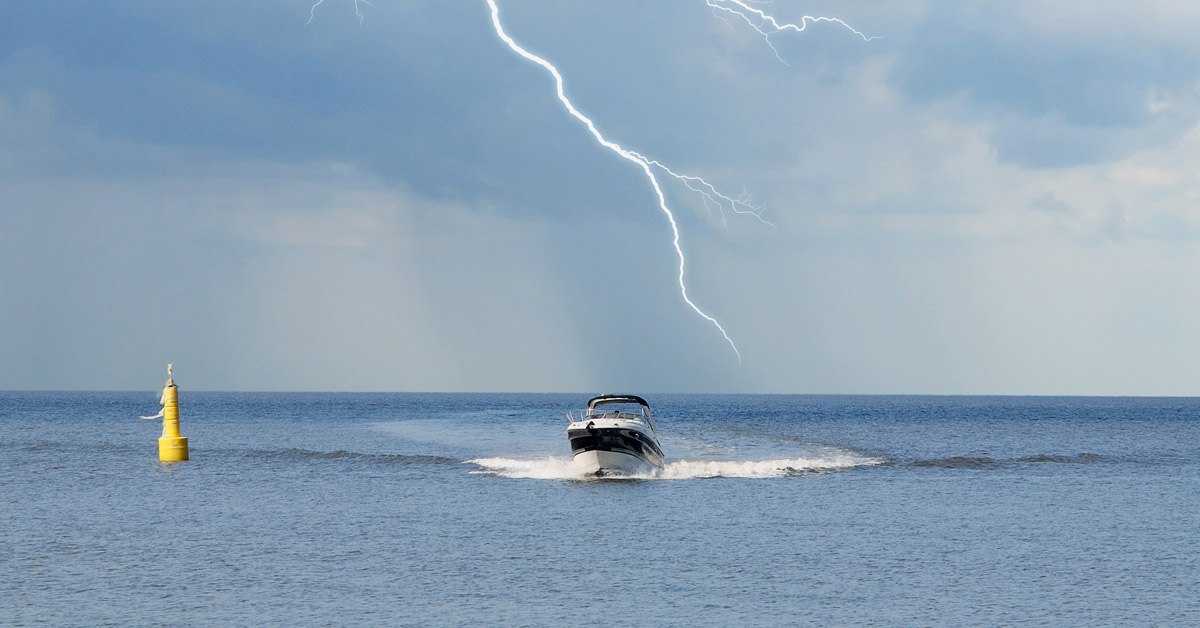
While there is much disagreement about thunderstorms and lightning, there is one universal agreement—avoid them entirely if at all possible. That can only be done if you have some means of learning of their impending presence ahead of time.
Although you should always check the official weather forecast before you go boating, you should always be watching out for the development of any of these dangerous conditions:
- Fog, dark clouds and lightning.
- A falling barometer (If the barometer falls, you can expect rain to fall too).
- A noticeable halo around the sun or moon (this usually indicates rain).
- Changes in the direction and temperature of the wind (a drop in temperature indicates a storm).
- Puffy, vertically rising clouds.
- Watch out for the West: Foul weather usually comes from the west, but storms from the east tend to be the most powerful.
It does help to have a warning in advance of the spectacle in the sky. Such a warning could come from the National Oceanic and Atmospheric Administration’s (NOAA) National Weather Service (NWS) via radio or online. The NWS has established radio transmitters all across the United States with a specific set of frequencies available on most VHF-FM marine radios, as well as specific weather radio receivers with warning alert systems that will sound off when there is a weather emergency in your vicinity. If you don’t have a marine radio on your boat, these weather radios are small, battery-operated and convenient to carry on the smallest of vessels.
Knowledge of upcoming weather is vital to ensuring a safe trip on the water. Advance knowledge can offer a means of advance preparation and that could mean survival of your property and/or the life of yourself and your passengers. So make sure to check the NWS online while planning your trip and ensure that you have a way to receive weather alerts during your float, either on your phone or via radio.
NOAA provides the following warning levels:
Small Craft Advisory:
A warning of weather conditions that may be dangerous for small boats. This warning indicates winds of at least 18 knots (24 mph) and rough, wavy conditions.
Gale Warning:
A warning of strong winds within the range of 34-47 knots (39-54 mph).
Storm Warning:
A warning of winds within the range of 48-63 knots (55-73 mph).
Hurricane Warning:
A warning that indicates hurricane winds of 64 knots (74 mph) and higher. This warning identifies that a combination of dangerously high water and rough seas are expected to impact a specified coastal area.
Thunderstorms usually mean a triple threat: 1) Heavy, flooding rain; 2) Unusually heavy and sudden winds; and 3) Potentially destructive lightning.
If you get caught in a storm, take the following actions:
- Step 1) Make sure every passenger is wearing a life jacket.
- Step 2) Reduce your speed and maintain your movement forward.
- Step 3) Turn on your required navigation lights—you may not be the only boater out there.
- Step 4) Seat your passengers on the bottom of the boat, along the centerline. This will help stabilize the boat and prevent your passengers from falling overboard.
- Step 5) Stow away any loose gear. A wakeboard or fishing pole can catch the wind and fly at you or your passengers.
- Step 6) Cut through large waves at a 45° angle—this will reduce the chance of your boat being swamped by them. If you’re operating a personal watercraft, cut through the waves at a 90° angle to help maintain lateral stability.
- Step 7) Keep the bilges free of water in order to stay well above water level (make sure you have a good bailer or working bilge pump on board).
- Step 8) If it’s safe to do so, head toward shore.
If you get caught in a storm and you’re unable to return to shore safely, you should anchor your boat. Here’s how:
- Step 1) Angle the boat as though you were still moving, at a 45° angle, headed into the waves. This positioning will prevent the boat from drifting or from being swamped by waves.
- Step 2) Drop the anchor from the bow of the boat.
- Step 3) Stay low in the boat and turn off the electrical equipment while you wait for the storm to pass.
- Step 4) Use your sound signaling device to indicate to other boaters that you’re at anchor. To do this, sound a signal rapidly for about five seconds in intervals of not more than one minute.
- Step 5) If you find yourself in need of rescue, use the appropriate visual distress signal equipment.
- Step 6) If you find yourself without an anchor, the Coast Guard recommends using a bucket and rope as an emergency anchor.
Note: If you cannot reach your destination safely, you should seek shelter for the duration of the storm. Safe shelters include marked areas for mooring or bays and docking areas that are protected by breakwaters.
Knowing what weather is on the horizon and being prepared for running into storms while on the water can help keep you, your passengers, and your vessel safe.


